- Home
- Publications et statistiques
- Publications
- Monthly Business Survey – Start of April...
The Banque de France publishes a range of monthly and quarterly economic surveys that provide a snapshot of the French economy in the form of business climate indicators and short-term forecasts.
According to the business leaders surveyed (approximately 8,500 companies and establishments questioned between 27 March and 3 April, i.e. mostly just before the 2 April announcements by the United States of significant and widespread increases in tariffs), activity in March grew in industry and market services but changed little in construction. In April, business leaders expect activity to remain on an upward trajectory in market services and industry (but at a slower pace than in March), and to change little in construction. Order books continue to be deemed weak across all industrial sectors, with the exception of aeronautics.
Business leaders report a lack of visibility due to the national and international context, particularly due to the possible effects of the expected increases in customs tariffs by the United States. Nevertheless, our uncertainty Indicator has risen only slightly from its high levels, given that our survey was mainly conducted before the US announcements of 2 April.
Increases in raw materials prices are considered very moderate in industry. Selling prices have returned to normal, and this is now also the case in market services.
Based on the survey results, together with other indicators, we estimate that GDP should grow by around 0.2% in the first quarter of 2025, following a decrease of 0.1% in thefourth quarter of 2024.
1. In March, activity grew in industry and market services, but changed little in construction
In March, activity actually grew for the third consecutive month at a level above the long-term average, even though last month business leaders in industry had forecast it would stabilise. Activity is mainly driven by the aeronautics and automotive sectors. Amidst uncertainty over the future of the sector (bases of transition to the electric car), manufacturers are increasing their production of older models, particularly hybrid vehicles. Wearing apparel-textiles-footwear continued to grow, particularly in the luxury products sector in anticipation of increases in US tariffs. Conversely, other industrial products and computer-electronics-optical products declined slightly.
The capacity utilisation rate (CUR) for industry as a whole was 75.4% in March (compared with 75.2% in February), well below its long-term average (77.2%). It increased in pharmaceuticals and transport equipment (up 1 percentage point), but fell back 1 percentage point in the chemicals and computer-electronics-optical products sectors.
Business leaders reported that inventories of finished goods decreased very slightly when compared with February. The reductions recorded in the aeronautics, machinery and equipment sectors – and to a lesser extent in the agri-food and computer-electronics-optical products sectors – were offset by increases in the pharmaceutical, wood-paper-printing and automotive sectors. In most sectors, the balance of opinion on inventories was above the long-term average, with the exception of wearing apparel-textiles-footwear and computer-electronics-optical products.
In market services, after a pause in February, activity picked up again at a moderate pace in March in line with the previous month’s expectations of business leaders. It recovered in information services and continued to grow in the accommodation and food services, publishing and cleaning sectors. However, it declined in the temporary employment and motor vehicle rental segments (customers renting for shorter periods).
BALANCE OF OPINION ON THE OUTLOOK FOR ACTIVITY (balance of opinion, adjusted for seasonal and working-day variations; forecast for April)
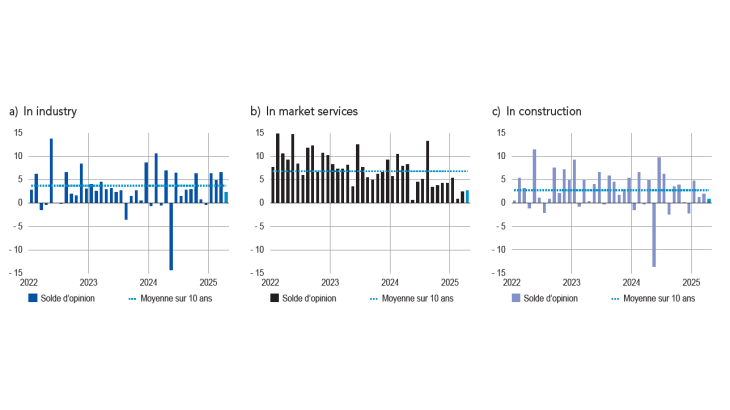
the past month) stood at 7 percentage points for April in industry. For April (light blue bar), business leaders in industry expect activity to increase by 2 percentage points.
CAPACITY UTILISATION RATE (%)
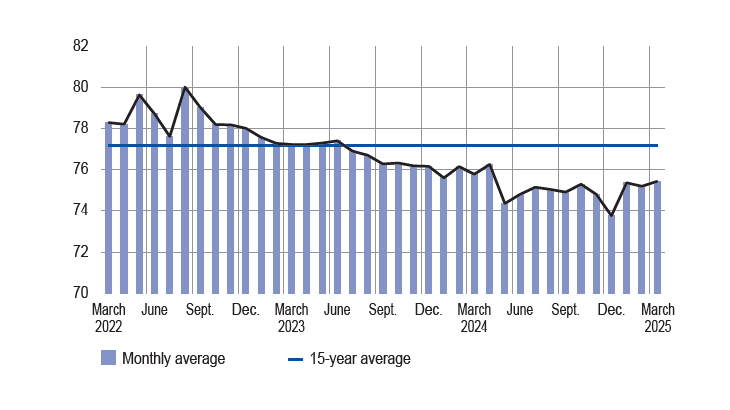
INVENTORIES OF FINISHED GOODS IN INDUSTRY (balance of opinion, adjusted for seasonal and working day variations)
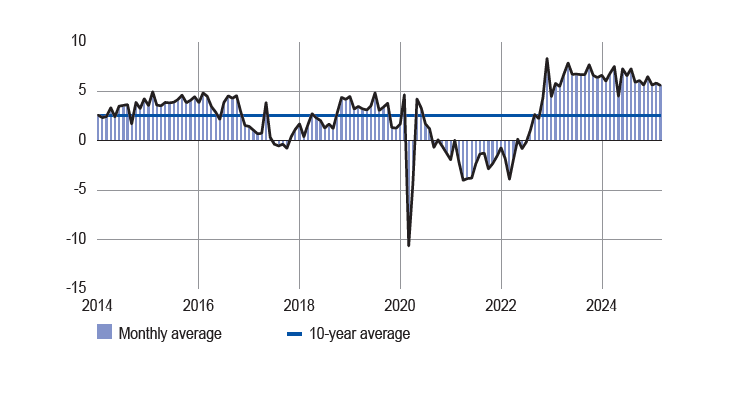
Activity grew very slowly in construction as forecast by business leaders last month. It recovered in structural works but slowed down slightly in finishing works. Business leaders in the structural works sector reported a slight upturn in demand for standalone housing in line with lower interest rates and the renewal of the zero-interest loan scheme.
The balance of opinion on cash positions remained slightly negative in industry. It deteriorated chiefly in aeronautics, computer, electronic and optical products and in other industrial products. However, it remained high in pharmaceuticals and improved in wearing apparel-textiles-footwear, as well as in machinery and equipment.
Company managers reported longer payment terms and difficulties in passing on recent price increases for certain raw materials (copper, lead and steel) as unfavourable factors for business cash flow. In all industrial sectors, the balance of opinion remained below its long-term average, particularly in electrical equipment, chemicals and in the rubber and plastic products sector.
In market services, there was a slight decline in the balance of opinion on cash positions, although it remained slightly positive and there was considerable disparity between sub-sectors. The cash position was deemed to be satisfactory in publishing and in the motor vehicle rental segment to a lesser extent. However, it was deemed weak in advertising, accommodation and food services, vehicle repairs and cleaning.
CASH POSITION (balance of opinion, adjusted for seasonal and working day variations)
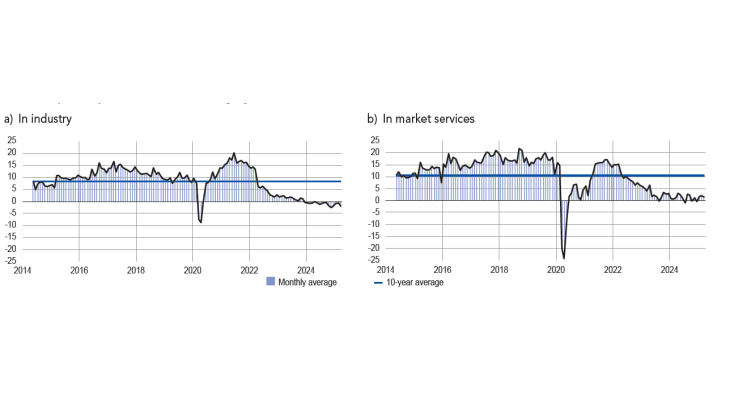
2. In April, business leaders expect activity
to decline in industry and construction,
but to remain stable in market services
In April, according to business leader forecasts (mainly compiled before the 2 April announcements of tariff increases by the United States), activity should continue to grow, but at a slower pace. It is expected to remain on an upward trajectory in aeronautics (still buoyed by the space industry and military equipment sectors) and in the automotive industry, to recover in computer, electronic and optical products, and to strengthen in the agri-food sector. However, it is expected to decline in the rubber and plastic products and wearing apparel-textiles-footwear sectors(negative impact expected from increases in US tariffs).
In market services, the growth in activity should remain moderate. It should increase notably in engineering and leisure activities and in personal services, and remain on an upward trajectory in publishing and information services. However, it is expected to continue trending downwards in the temporary work and vehicle rental sectors.
Lastly, in construction, activity is forecast to remain stable, buoyed by finishing works, whereas structural work is expected to decline.
At the end of March, industrial order books were still considered weak (well below their medium- to long-term averages) in all sectors apart from aerospace. They were especially weak in computer, electronic and optical products, machinery and equipment, rubber and plastic products and chemicals.
In construction, the opinion on order books turned negative once again in the finishing works sector and continued to bevery poor in the structural works sector.
Our monthly uncertainty indicator, which is constructed from a textual analysis of comments by surveyed companies, rose very slightly in March in all three sectors. Business leaders stress a lack of visibility due to the national and international context. More specifically, they refer to increases in US tariffs, particularly in the metal and metal products, machinery and equipment, agri-food and transport equipment sectors.
LEVEL OF ORDER BOOKS (balance of opinion, adjusted for seasonal and working day variations)
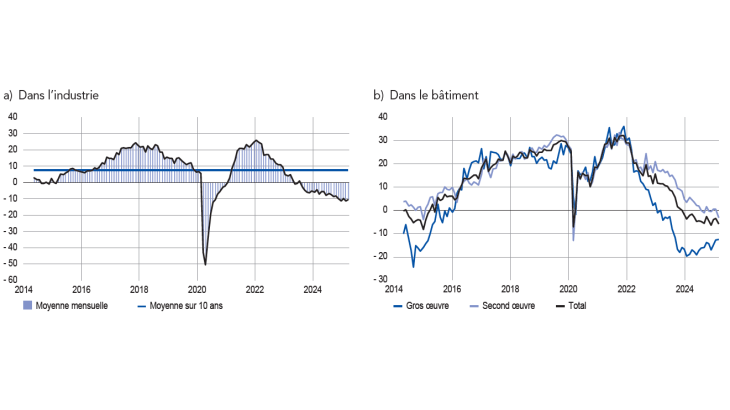
INDICATOR OF UNCERTAINTY IN THE COMMENTS SECTION OF THE MONTHLY BUSINESS SURVEY (MBS)
(unadjusted data)
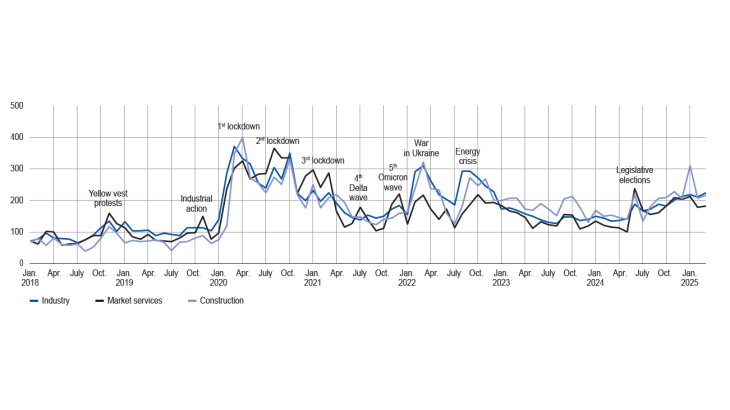
Note: The reference value is set at 100 and corresponds to the value around which the indicator fluctuates in normal periods.
3. Selling prices have returned to normal – and this is now also the case in market services
In March, supply difficulties were generally stable compared to the previous month (10% of companies reported them, compared to 9% in February). In the transport sector, which was the most affected, they rose again in aeronautics (33%), but declined slightly in the automotive sector (11%). Supply difficulties continued to be rare in the construction sector (2%).
In industry, business leaders reported that raw materials prices increased very slightly, notably in the machinery and equipment sector (higher price of steel). The balance of opinion on finished goods prices1 remains generally close to zero:,price increases in certain sectors (agri-food, aeronautics and other industrial products) are offset by decreases in others (i.e. the automotive, pharmaceuticals and chemicals sectors).
CHANGE IN PRICES OF FINISHED GOODS BY MAJOR SECTOR (balance of opinion, adjusted for seasonal and working day variations)
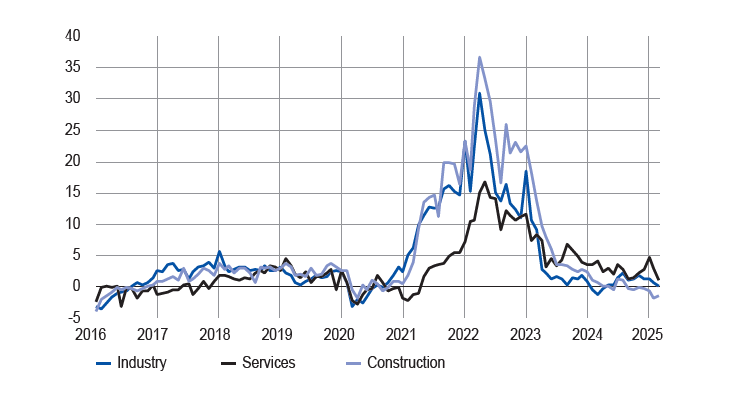
More specifically, 10% of business leaders in industry reported that they had raised their selling prices in March, close to pre-Covid March figures and below the same monthbetween 2021 and 2023. Price rises mainly concerned agri-food (27%), aeronautics (11%), and wood-paper-printing and chemicals (10%). Conversely, 5% of business leaders in industry reported cutting their selling prices, a higher proportion than in the month of March before Covid. Decreases in finished goods prices were mainly concentrated in the automotive, woodpaper-printing and metal and metal products sectors (10%).
In construction, the balance of opinion on price movements remained negative in March, in both structural and finishing works. 4% of business leaders reported increasing their quote prices, which was less than the level observed in March of previous years. Conversely, 12% of business leaders (11% in March 2024) said they had reduced their quote prices, a much higher proportion than in March of previous years.
In services, the balance of opinion declined considerably and is now comparable to pre-Covid levels. The proportion of companies reporting an increase in prices was 9%, well down on March figures for the last three years, and at similar levels to pre-Covid March figures. At the same time, the proportion of companies reporting a drop in their rices was 4%, on a par with figures reported in March of previous years, including during the pre-Covid period. Price rises mainly concerned accommodation, advertising, transport and storage and legal and accounting activities.
SHARE OF BUSINESSES REPORTING RECRUITMENT DIFFICULTIES (%, unadjusted data)
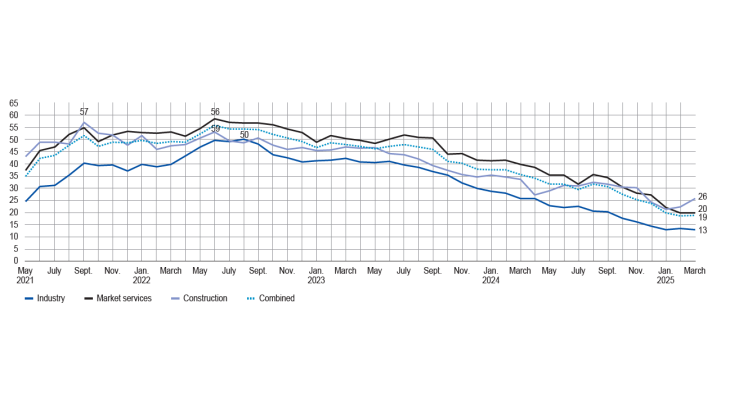
The proportion of business leaders who intend to increase their selling prices in April is 7% in industry and market services, and 3% in construction.
In March, 19% of business leaders reported recruitment difficulties2 (the same proportion as in February).
4. Our estimates suggest that GDP will edge up in the first quarter, by around 0.2%.
Based on the results of the Banque de France monthly business survey (MBS), rounded out by other available data (INSEE service and industry production indices and surveys and high-frequency data), we forecast that GDP will grow by around 0.2% in the first quarter of 2025.
GDP growth this quarter should be buoyed by a rebound in value added in market services and manufacturing, in the wake of a decline in both sectors in the previous quarter (due to the negative counter effects of the Olympic and Paralympic Games for services).
Value added is expected to stabilise in the energy sector and should decline slightly in construction.
QUARTERLY CHANGES IN GDP AND VALUE ADDED IN FRANCE (%)
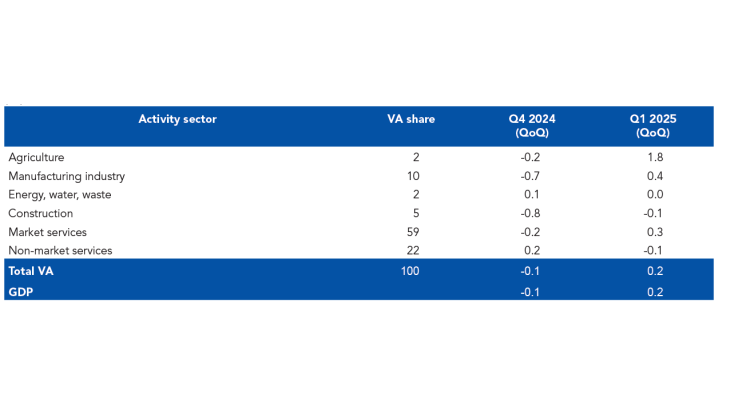
Note: QoQ = quarterly change.
Sources: INSEE data for the fourth quarter of 2024, Banque de France forecast for the first quarter of 2025.
1 The balance of opinion is the difference between the proportion of business leaders reporting increases or decreases, weighted by the intensity of the variation (with three possible grades in the monthly business survey: low, normal and high). A business leader indicating a “high” increase in prices will, all other things being equal, influence the balance of opinion more than a business leader indicating a “low” increase.
2 2 The series of supply and recruitment difficulties have been methodologically revised for the 2021-24 period; more specifically, the series in the construction sector has been revised downwards, without actually altering the trends. See Methodologies.
Download the full publication
Updated on the 17th of April 2025